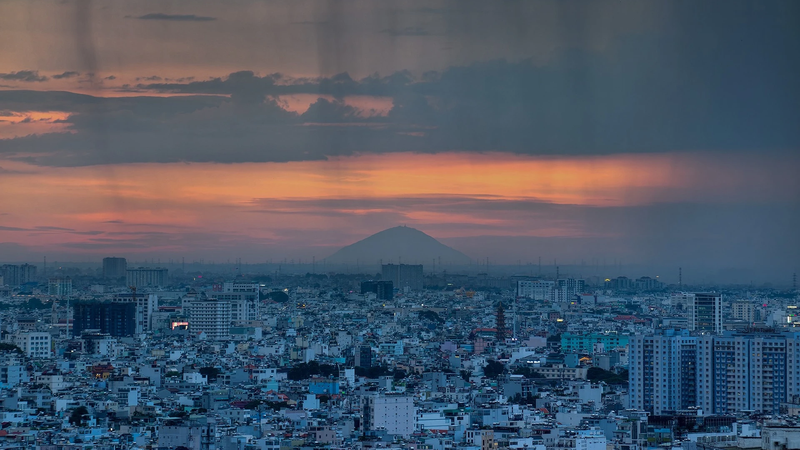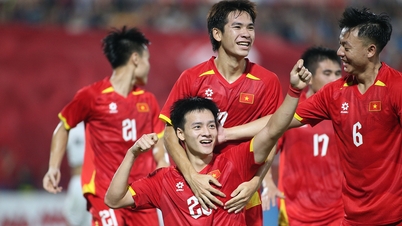On the afternoon of April 22, the spot gold price in the Asian market increased sharply, at times increasing by nearly 100 USD, to about 3,495 USD/ounce (equivalent to 111 million VND/tael). In the domestic market, the price of SJC gold jumped to 124 million VND/tael, compared to 90 million VND/tael in early March.
The surge is reminiscent of historic gold rushes like 1979-1980 or 2010-2011, which were followed by sharp declines. What is behind these fluctuations and will gold prices collapse again?
The Gold Rush of 1979-1980 and the Crash of 1980-1982
From early 1979 to early 1980, the world gold price skyrocketed from 230 USD/ounce to a historic peak of 850 USD/ounce in January 1980, equivalent to an increase of about 3.7 times in less than a year.
The main cause was global economic and geopolitical instability. Inflation in the US increased rapidly, reaching nearly 14.5% in 1980, due to the sharp increase in oil prices after the 1979 oil crisis along with the US's loose monetary policy in the previous years.
The US dollar weakened severely after the US ended the gold standard in 1971 (a system that guaranteed the value of the USD in gold).
Geopolitically, the world also faced many upheavals: the Iranian Islamic Revolution (1979) disrupted oil production, while the Afghanistan-Soviet conflict that broke out from late 1979 further aggravated the situation.
In times of instability, gold becomes a safe haven asset, attracting cash flows from individual investors and hedge funds, contributing to fueling the gold rush.
However, gold prices witnessed a sharp decline after that, lasting from late 1980 to mid-1982. From a peak of $850/ounce, prices fell to around $320/ounce, equivalent to a drop of about 62%, a huge shock to the market.
The main reason was the sharp increase in the value of the USD after the US Federal Reserve (Fed) switched to a tight monetary policy. At its peak, the basic interest rate was raised to 20% in June 1981 to curb inflation.
Along with that, market sentiment is more stable as geopolitical tensions gradually ease, causing demand for safe haven gold to decline.
In Vietnam, the domestic gold market during this period was not connected with the world due to the centrally planned economy and limited foreign exchange transactions.

World gold prices have increased sharply and then decreased sharply in the past. Photo: UN
The gold fever of 2010-2011 and then the decline from 2011-2015
In less than two years, from early 2010 to August 2011, the world gold price nearly doubled, from about 1,000 USD/ounce to 1,825 USD/ounce.
This price increase comes from the severe consequences of the global financial crisis of 2008-2009, when the US and European economies fell into a severe recession. The Fed maintained interest rates near 0%, while pumping money through quantitative easing (QE) programs, causing the USD to weaken and inflation expectations to rise.
At the same time, the European debt crisis, especially in Greece, has increased concerns about the global financial system. Investors are looking for a safe haven in gold. In addition, the strong demand for physical gold from China and India, along with the continuous buying of gold ETFs, has pushed the price of gold higher.
However, from a peak of $1,825 an ounce, gold prices began to fall sharply in 2013 and bottomed out at $1,060 an ounce in November 2015, almost erasing the previous gains.
The main reason comes from the change in monetary policy after the crisis. The Fed started to reduce the QE program from 2013, after pumping trillions of dollars into the economy. Inflation decreased, the USD recovered, the US economy grew again, the stock market boomed,... all of which reduced the attractiveness of gold.
Meanwhile, gold ETFs saw strong selling, while physical demand from Asia slowed. Geopolitical tensions and the European debt crisis also eased, especially after Greece reached a debt deal with the EU.
In Vietnam, the price of SJC gold fluctuated strongly, from 35 million VND/tael in 2010, increased to 49 million VND/tael in 2011, then decreased to 34 million VND/tael in 2015.
The world is aiming for 3,500 USD/ounce, SJC is aiming for 130 million: Is there a risk of collapse?
The world and domestic gold markets are experiencing a price increase that has lasted from the end of 2023 until now. From April 2024 to April 2025 alone, the world gold price has increased by nearly 60%, from 2,200 USD/ounce to 3,495 USD/ounce.
The domestic SJC gold price also skyrocketed, from VND80 million/tael (April 2024) to VND99 million/tael (April 2025) and is currently approaching VND130 million/tael.
This price increase is linked to many economic and geopolitical factors, especially the policies of President Donald Trump's administration after he took office for a second time in January 2025. The resumption of high tariffs on goods from China and many other countries has escalated the trade war, raised concerns about inflation and weakened confidence in the USD.
Geopolitical tensions are also an important driver of gold prices. The prolonged Russia-Ukraine conflict, coupled with mutual economic sanctions between Russia and the West, has increased demand for gold. Meanwhile, instability in the Middle East, especially between Israel and regional forces, continues to push global geopolitical risks higher.
The US economy, although still growing, is facing pressure from a public debt exceeding 36,700 billion USD and persistent inflation, causing investors to seek gold as a channel to preserve assets.
Gold demand from central banks, especially from China, India and emerging markets, is also expected to increase sharply. China will buy a record 225 tonnes of gold in 2023 and continue to accumulate in 2024-2025 to reduce its dependence on the US dollar.
At the same time, gold ETFs returned to buying after a previous period of net selling.
Although gold prices are at record highs, the risk of a reversal like the periods 1980-1982 and 2011-2015 still exists. If the Fed is forced to tighten monetary policy to control inflation, rising interest rates could strengthen the US dollar, reducing the attractiveness of gold.
A thaw in Ukraine or the Middle East could also dampen safe-haven demand, putting pressure on gold prices. Gold ETFs, which are sensitive to market volatility, could see selling if stocks or cryptocurrencies become more attractive. Additionally, a thaw in the US-China trade war could also dampen global physical gold demand.
Some forecasts suggest that the world gold price could fall to $2,500-2,800/ounce by the end of 2025, equivalent to a 20-30% drop from the current peak. On Business Insider, some experts even said that gold could fall to $1,820/ounce within the next 5 years, a drop of nearly 48% compared to April 22.
In Vietnam, if the world gold price decreases according to this scenario, the domestic SJC gold price could fall to about 60 million VND/tael, while ring gold would be about 58 million VND/tael.
Vietnamnet.vn
Source: https://vietnamnet.vn/gia-vang-huong-moc-130-trieu-dong-luong-lieu-co-tai-dien-cu-lao-doc-lich-su-2393966.html


![[Photo] President Luong Cuong receives Speaker of the Korean National Assembly Woo Won Shik](/_next/image?url=https%3A%2F%2Fvphoto.vietnam.vn%2Fthumb%2F1200x675%2Fvietnam%2Fresource%2FIMAGE%2F2025%2F11%2F21%2F1763720046458_ndo_br_1-jpg.webp&w=3840&q=75)
![[Photo] Visit Hung Yen to admire the "wooden masterpiece" pagoda in the heart of the Northern Delta](/_next/image?url=https%3A%2F%2Fvphoto.vietnam.vn%2Fthumb%2F1200x675%2Fvietnam%2Fresource%2FIMAGE%2F2025%2F11%2F21%2F1763716446000_a1-bnd-8471-1769-jpg.webp&w=3840&q=75)


![[Photo] General Secretary To Lam receives President of the Senate of the Czech Republic Milos Vystrcil](/_next/image?url=https%3A%2F%2Fvphoto.vietnam.vn%2Fthumb%2F1200x675%2Fvietnam%2Fresource%2FIMAGE%2F2025%2F11%2F21%2F1763723946294_ndo_br_1-8401-jpg.webp&w=3840&q=75)
![[Photo] National Assembly Chairman Tran Thanh Man holds talks with President of the Senate of the Czech Republic Milos Vystrcil](/_next/image?url=https%3A%2F%2Fvphoto.vietnam.vn%2Fthumb%2F1200x675%2Fvietnam%2Fresource%2FIMAGE%2F2025%2F11%2F21%2F1763715853195_ndo_br_bnd-6440-jpg.webp&w=3840&q=75)






































































































Comment (0)